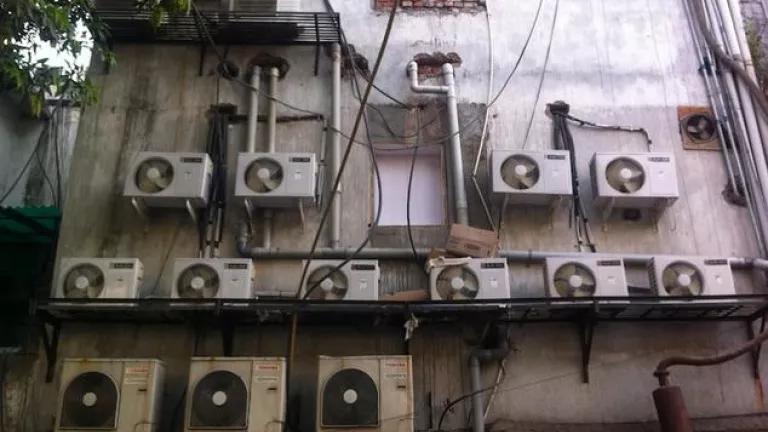Spotlight on Climate Friendly Cooling in India
Finance and investment in technology are critical in mainstreaming hydrofluorocarbons (HFCs) transitions in India, as NRDC and partners discussed at the Montreal Protocol meeting (MOP34) last month.

Air conditioners in New Delhi, India
Bhaskar Deol/NRDC
Co-authored with Ashish Jindal
With the past eight years on track to be the eight warmest on record, climate friendly cooling continues to be a topic of global discussion as the Executive Committee of Montreal Protocol’s Multilateral Fund (MLF) meets this week. The Montreal Protocol has been instrumental in moving forward on climate friendly cooling through refrigerant transitions, and parties at the MLF meeting are deliberating on funding arrangements. Finance and investment in technology are critical in mainstreaming hydrofluorocarbons (HFCs) transitions in India, as NRDC and partners discussed at a side event at the Montreal Protocol meeting (MOP34) last month.
HFCs, used frequently in air conditioning units, refrigerators and other equipment, are the fastest growing climate pollutants. Kilogram for kilogram, they are hundreds to thousands of times more potent than carbon dioxide. A successful HFC phasedown will avoid adding nearly a half degree Celsius (one degree Fahrenheit) of warming by the end of the century.
The Kigali Amendment of the Montreal Protocol, one of the world’s most successful environmental treaties, is intended to phase down HFCs over the next two decades. After playing a key role in the success of the original treaty, India has continued to show support. India signed the Kigali Amendment in 2016, and again sent a strong signal to industry and other nations that it is serious about phasing down HFCs by ratifying the Amendment in September 2021. The country’s national strategy for phasing down HFCs will be completed by end of 2023.
As India moves forward with the implementation of its Cooling Action Plan (ICAP), it can also plan for timely action on HFCs and maximize the phase down gains both in terms of emissions and time.
Key Take Aways from MOP34 Side Event on India
In this context, NRDC and The Energy and Resources Institute (TERI) organized a side event, Mainstreaming HFC Transitions in Ensuring Access to Cooling in India, at the 34th MOP to think through top-down and bottom-up approaches to implement the ICAP and mainstream alternative low GWP refrigerants, opportunities for India to maximize HFC phase down gains, and ways of leveraging domestic and international sources of climate finance including the Multilateral Fund to support innovative cooling solutions.

Discussions on Cooling at MOP34 India Side Event in Montreal
NRDC
The experts highlighted the following:
- India plans for HFC transitions and access to cooling solutions to be built on the three pillars: scale, speed and skill. Solutions are to be applied at scale, with more speed, and with an ecosystem for implementation on the way.
- Climate friendly cooling technologies are available today, but the market needs to be ready for adoption to ensure access and successful implementation. A ready market includes proper safety standards for handling new refrigerants, technician training, capacity building to properly install and service the equipment, and overall awareness building for users of these gases and cooling equipment.
- Suitable incentives, market-based mechanisms and regulatory tools will need to be devised to ensure a smooth transition to low GWP refrigerants.
- As the ICAP highlights, India’s demand for cooling will increase eight times by 2037 and a large part of this demand will be from space cooling. With yet to be constructed buildings, there is an opportunity to reduce cooling and refrigerant demand through efficient building design and enhanced efficiency of new appliances. Efficient building design is also a very effective way of ensuring thermal comfort.
- The World Bank estimates the investment opportunity in cooling in India will be US $1.6 trillion by 2050. A major share belongs to space cooling. Finding suitable ways of achieving these investment levels will be critical and require mechanisms such as cap and trade around efficient cooling, outcome based bonds linked to cooling, getting the private sector more involved by unlocking the market (such as through bulk procurement programs).
- India loses around $13-15 billion in food losses annually largely due to lack of cold chain infrastructure. This costs the farmer 15-28% loss in their annual revenue. Access to cooling is not just an issue about saving the planet but also about social development and poverty alleviation. Various models that are at the cusp of adoption use financial models such as assets on lease, cooling as service and pay-as-you-go. Solutions could also include suitable incentive mechanism programs for technologies which stand out for their climate gains.
- Moving forward on cooling at the sub-national level at state and city level will be critical for the implementation of the ICAP. For example, creating capacities and institutional strengthening at the state level could aid in cooling load reduction strategy implementation, as could state level roadmaps.
At the side event, NRDC experts and colleagues presented a new paper in Environmental Research Letters, laying out a pathway for India to phase down HFCs without infringing on the nation’s effort to scale up access to cooling for millions. The side event concluded that India’s cooling sector has already shown proactive action; with greater stakeholder collaboration and with a few smart and timely actions, India’s industries cans support additional successful long term climate friendly cooling gains.
The MOP34 itself concluded with positive progress on its key agenda items, where countries adopted the terms of reference for the study on the replenishment of the Multilateral Fund (MLF) for 2024-2026. The countries also recognized the need to allocate funds to improve energy efficiency while phasing down HFCs, as well as mainstream energy efficiency-related matters into the annual work of the treaty’s Technology and Economic Assessment Panel (TEAP), a step that will give the issue proper roots in this forum and more.
Ashish Jindal is a cooling and energy efficiency expert working with NRDC as a consultant based in New Delhi.




